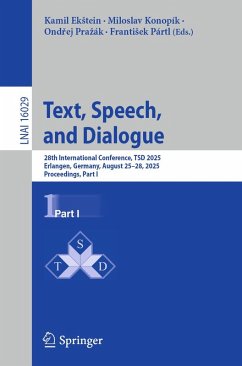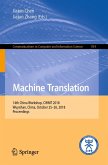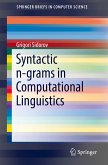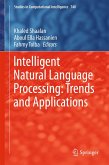Text, Speech, and Dialogue (eBook, PDF)
28th International Conference, TSD 2025, Erlangen, Germany, August 25-28, 2025, Proceedings, Part I
Redaktion: Ekstein, Kamil; Pártl, Frantisek; Prazák, Ondrej; Konopík, Miloslav
104,95 €
104,95 €
inkl. MwSt.
Sofort per Download lieferbar

52 °P sammeln
104,95 €
Als Download kaufen

104,95 €
inkl. MwSt.
Sofort per Download lieferbar

52 °P sammeln
Jetzt verschenken
Alle Infos zum eBook verschenken
104,95 €
inkl. MwSt.
Sofort per Download lieferbar
Alle Infos zum eBook verschenken

52 °P sammeln
Text, Speech, and Dialogue (eBook, PDF)
28th International Conference, TSD 2025, Erlangen, Germany, August 25-28, 2025, Proceedings, Part I
Redaktion: Ekstein, Kamil; Pártl, Frantisek; Prazák, Ondrej; Konopík, Miloslav
- Format: PDF
- Merkliste
- Auf die Merkliste
- Bewerten Bewerten
- Teilen
- Produkt teilen
- Produkterinnerung
- Produkterinnerung

Bitte loggen Sie sich zunächst in Ihr Kundenkonto ein oder registrieren Sie sich bei
bücher.de, um das eBook-Abo tolino select nutzen zu können.
Hier können Sie sich einloggen
Hier können Sie sich einloggen
Sie sind bereits eingeloggt. Klicken Sie auf 2. tolino select Abo, um fortzufahren.

Bitte loggen Sie sich zunächst in Ihr Kundenkonto ein oder registrieren Sie sich bei bücher.de, um das eBook-Abo tolino select nutzen zu können.
This conference volume constitutes the proceedings of the 28th International Conference on Engineering on Text, Speech, and Dialogue, TSD 2025, held in Erlangen, Germany, in August 2025.
The 60 full papers were presented in this volume were carefully reviewed and selected from 122 submissions. They focus on speech and language technologies and computer processing of speech and language related data.
- Geräte: PC
- ohne Kopierschutz
- eBook Hilfe
- Größe: 34.19MB
Andere Kunden interessierten sich auch für
![Text, Speech, and Dialogue (eBook, PDF) Text, Speech, and Dialogue (eBook, PDF)]() Text, Speech, and Dialogue (eBook, PDF)104,95 €
Text, Speech, and Dialogue (eBook, PDF)104,95 €![Machine Translation (eBook, PDF) Machine Translation (eBook, PDF)]() Machine Translation (eBook, PDF)40,95 €
Machine Translation (eBook, PDF)40,95 €![Syntactic n-grams in Computational Linguistics (eBook, PDF) Syntactic n-grams in Computational Linguistics (eBook, PDF)]() Grigori SidorovSyntactic n-grams in Computational Linguistics (eBook, PDF)40,95 €
Grigori SidorovSyntactic n-grams in Computational Linguistics (eBook, PDF)40,95 €![Using Comparable Corpora for Under-Resourced Areas of Machine Translation (eBook, PDF) Using Comparable Corpora for Under-Resourced Areas of Machine Translation (eBook, PDF)]() Using Comparable Corpora for Under-Resourced Areas of Machine Translation (eBook, PDF)104,95 €
Using Comparable Corpora for Under-Resourced Areas of Machine Translation (eBook, PDF)104,95 €![Semantics (eBook, PDF) Semantics (eBook, PDF)]() András KornaiSemantics (eBook, PDF)60,95 €
András KornaiSemantics (eBook, PDF)60,95 €![Intelligent Natural Language Processing: Trends and Applications (eBook, PDF) Intelligent Natural Language Processing: Trends and Applications (eBook, PDF)]() Intelligent Natural Language Processing: Trends and Applications (eBook, PDF)216,95 €
Intelligent Natural Language Processing: Trends and Applications (eBook, PDF)216,95 €![Progress in Artificial Intelligence (eBook, PDF) Progress in Artificial Intelligence (eBook, PDF)]() Progress in Artificial Intelligence (eBook, PDF)59,95 €
Progress in Artificial Intelligence (eBook, PDF)59,95 €-
-
-
This conference volume constitutes the proceedings of the 28th International Conference on Engineering on Text, Speech, and Dialogue, TSD 2025, held in Erlangen, Germany, in August 2025.
The 60 full papers were presented in this volume were carefully reviewed and selected from 122 submissions. They focus on speech and language technologies and computer processing of speech and language related data.
The 60 full papers were presented in this volume were carefully reviewed and selected from 122 submissions. They focus on speech and language technologies and computer processing of speech and language related data.
Dieser Download kann aus rechtlichen Gründen nur mit Rechnungsadresse in A, B, BG, CY, CZ, D, DK, EW, E, FIN, F, GR, HR, H, IRL, I, LT, L, LR, M, NL, PL, P, R, S, SLO, SK ausgeliefert werden.
Produktdetails
- Produktdetails
- Verlag: Springer International Publishing
- Seitenzahl: 409
- Erscheinungstermin: 21. August 2025
- Englisch
- ISBN-13: 9783032025487
- Artikelnr.: 75259731
- Verlag: Springer International Publishing
- Seitenzahl: 409
- Erscheinungstermin: 21. August 2025
- Englisch
- ISBN-13: 9783032025487
- Artikelnr.: 75259731
- Herstellerkennzeichnung Die Herstellerinformationen sind derzeit nicht verfügbar.
.- Speech.
.- Lightweight Target-Speaker-Based Overlap Transcription for Practical Streaming ASR.
.- An Empirical Analysis of Discrete Unit Representations in Speech Language Modeling Pre-training.
.- Optimizing ASR Models with Semantic Information.
.- Efficient Enhancement of Norwegian ASR Model.
.- Towards Stable and Personalised Profiles for Lexical Alignment in Spoken Human-Agent Dialogue.
.- Audio Vision Contrastive Learning for Phonological Class Recognition.
.- TOSD-Net: A CNN-Transformer Architecture for Robust Frame-Level Overlapping Speech Detection in Diverse Acoustic Conditions.
.- An Exploration of ECAPA-TDNN and x-vector Speaker Representations in Zero-shot Multi-speaker TTS.
.- Emotion-Aware Speech-Driven Facial Avatar Animation via Joint Blendshape Prediction and Emotion Recognition.
.- Beyond Static Emotions: Leveraging Multitask Learning to Model Dynamics of Dimensional Affect in Speech.
.- Implicit Speaker Group Encoding in Self-supervised Speech Recognition Models.
.- Combining Temporal Visual Dynamics and Audio Representations for Robust Speaker Identification.
.- Sentences vs Phrases in Neural Speech Synthesis: the Phrases Strike Back.
.- Evaluating Phoneme-Level Pretraining in Czech Text-to-Speech Synthesis.
.- Unifying Global and Near-Context Biasing in a Single Trie Pass.
.- Synthesising Cross-Speaker Data for Low-Resource Pathological Speech Recognition with PEFT.
.- Multilingual Stutter Event Detection for English, German, and Mandarin Speech.
.- How Far Can Synthetic Speech Go? Enhancing ASR in Low-Resource Scenarios via Voice Cloning.
.- Enhancing Detection of Parkinson-induced Dysarthria with Cross-lingual Transfer Learning.
.- Vocoder-Free Non-Parallel Conversion of Whispered Speech With Masked Cycle-Consistent Generative Adversarial Networks.
.- Detection of Cognitive Disorders Using ASR-Based Nonsense Words Repetition.
.- Mind the Gap: Entity-Preserved Context-Aware ASR for Structured Transcriptions.
.- Boosting CTC-Based ASR Using LLM-Based Intermediate Loss Regularization.
.- Robust Disfluency Labeling in Spontaneous Speech: Insights from Diverse Hungarian Corpora Including Mentally Ill Speakers.
.- ParCzech4Speech: A New Speech Corpus Derived from Czech Parliamentary Data.
.- Towards an Accurate Domain-Specific ASR: Transcription for Pathology.
.- Automated Speaking Assessment for L2 Learners of Czech.
.- Inclusive ASR for Critical Public Services: Debiasing with Actor-Simulated Speech.
.- RECA-PD: A Robust Explainable Cross-Attention Method for Speech-based Parkinson's Disease Classification.
.- Systematic FAIRness Assessment of Open Voice Biomarker Datasets for Mental Health and Neurodegenerative Diseases.
.- When Silence Speaks: Understanding Open-Ended Responses via LLMs in Therapeutic Voice Interaction.
.- Multilingual Domain Adaptation for Speech Recognition Using LLMs.
.- Using Cross-attention For Conversational ASR Over The Telephone.
.- Lightweight Target-Speaker-Based Overlap Transcription for Practical Streaming ASR.
.- An Empirical Analysis of Discrete Unit Representations in Speech Language Modeling Pre-training.
.- Optimizing ASR Models with Semantic Information.
.- Efficient Enhancement of Norwegian ASR Model.
.- Towards Stable and Personalised Profiles for Lexical Alignment in Spoken Human-Agent Dialogue.
.- Audio Vision Contrastive Learning for Phonological Class Recognition.
.- TOSD-Net: A CNN-Transformer Architecture for Robust Frame-Level Overlapping Speech Detection in Diverse Acoustic Conditions.
.- An Exploration of ECAPA-TDNN and x-vector Speaker Representations in Zero-shot Multi-speaker TTS.
.- Emotion-Aware Speech-Driven Facial Avatar Animation via Joint Blendshape Prediction and Emotion Recognition.
.- Beyond Static Emotions: Leveraging Multitask Learning to Model Dynamics of Dimensional Affect in Speech.
.- Implicit Speaker Group Encoding in Self-supervised Speech Recognition Models.
.- Combining Temporal Visual Dynamics and Audio Representations for Robust Speaker Identification.
.- Sentences vs Phrases in Neural Speech Synthesis: the Phrases Strike Back.
.- Evaluating Phoneme-Level Pretraining in Czech Text-to-Speech Synthesis.
.- Unifying Global and Near-Context Biasing in a Single Trie Pass.
.- Synthesising Cross-Speaker Data for Low-Resource Pathological Speech Recognition with PEFT.
.- Multilingual Stutter Event Detection for English, German, and Mandarin Speech.
.- How Far Can Synthetic Speech Go? Enhancing ASR in Low-Resource Scenarios via Voice Cloning.
.- Enhancing Detection of Parkinson-induced Dysarthria with Cross-lingual Transfer Learning.
.- Vocoder-Free Non-Parallel Conversion of Whispered Speech With Masked Cycle-Consistent Generative Adversarial Networks.
.- Detection of Cognitive Disorders Using ASR-Based Nonsense Words Repetition.
.- Mind the Gap: Entity-Preserved Context-Aware ASR for Structured Transcriptions.
.- Boosting CTC-Based ASR Using LLM-Based Intermediate Loss Regularization.
.- Robust Disfluency Labeling in Spontaneous Speech: Insights from Diverse Hungarian Corpora Including Mentally Ill Speakers.
.- ParCzech4Speech: A New Speech Corpus Derived from Czech Parliamentary Data.
.- Towards an Accurate Domain-Specific ASR: Transcription for Pathology.
.- Automated Speaking Assessment for L2 Learners of Czech.
.- Inclusive ASR for Critical Public Services: Debiasing with Actor-Simulated Speech.
.- RECA-PD: A Robust Explainable Cross-Attention Method for Speech-based Parkinson's Disease Classification.
.- Systematic FAIRness Assessment of Open Voice Biomarker Datasets for Mental Health and Neurodegenerative Diseases.
.- When Silence Speaks: Understanding Open-Ended Responses via LLMs in Therapeutic Voice Interaction.
.- Multilingual Domain Adaptation for Speech Recognition Using LLMs.
.- Using Cross-attention For Conversational ASR Over The Telephone.
.- Speech.
.- Lightweight Target-Speaker-Based Overlap Transcription for Practical Streaming ASR.
.- An Empirical Analysis of Discrete Unit Representations in Speech Language Modeling Pre-training.
.- Optimizing ASR Models with Semantic Information.
.- Efficient Enhancement of Norwegian ASR Model.
.- Towards Stable and Personalised Profiles for Lexical Alignment in Spoken Human-Agent Dialogue.
.- Audio Vision Contrastive Learning for Phonological Class Recognition.
.- TOSD-Net: A CNN-Transformer Architecture for Robust Frame-Level Overlapping Speech Detection in Diverse Acoustic Conditions.
.- An Exploration of ECAPA-TDNN and x-vector Speaker Representations in Zero-shot Multi-speaker TTS.
.- Emotion-Aware Speech-Driven Facial Avatar Animation via Joint Blendshape Prediction and Emotion Recognition.
.- Beyond Static Emotions: Leveraging Multitask Learning to Model Dynamics of Dimensional Affect in Speech.
.- Implicit Speaker Group Encoding in Self-supervised Speech Recognition Models.
.- Combining Temporal Visual Dynamics and Audio Representations for Robust Speaker Identification.
.- Sentences vs Phrases in Neural Speech Synthesis: the Phrases Strike Back.
.- Evaluating Phoneme-Level Pretraining in Czech Text-to-Speech Synthesis.
.- Unifying Global and Near-Context Biasing in a Single Trie Pass.
.- Synthesising Cross-Speaker Data for Low-Resource Pathological Speech Recognition with PEFT.
.- Multilingual Stutter Event Detection for English, German, and Mandarin Speech.
.- How Far Can Synthetic Speech Go? Enhancing ASR in Low-Resource Scenarios via Voice Cloning.
.- Enhancing Detection of Parkinson-induced Dysarthria with Cross-lingual Transfer Learning.
.- Vocoder-Free Non-Parallel Conversion of Whispered Speech With Masked Cycle-Consistent Generative Adversarial Networks.
.- Detection of Cognitive Disorders Using ASR-Based Nonsense Words Repetition.
.- Mind the Gap: Entity-Preserved Context-Aware ASR for Structured Transcriptions.
.- Boosting CTC-Based ASR Using LLM-Based Intermediate Loss Regularization.
.- Robust Disfluency Labeling in Spontaneous Speech: Insights from Diverse Hungarian Corpora Including Mentally Ill Speakers.
.- ParCzech4Speech: A New Speech Corpus Derived from Czech Parliamentary Data.
.- Towards an Accurate Domain-Specific ASR: Transcription for Pathology.
.- Automated Speaking Assessment for L2 Learners of Czech.
.- Inclusive ASR for Critical Public Services: Debiasing with Actor-Simulated Speech.
.- RECA-PD: A Robust Explainable Cross-Attention Method for Speech-based Parkinson's Disease Classification.
.- Systematic FAIRness Assessment of Open Voice Biomarker Datasets for Mental Health and Neurodegenerative Diseases.
.- When Silence Speaks: Understanding Open-Ended Responses via LLMs in Therapeutic Voice Interaction.
.- Multilingual Domain Adaptation for Speech Recognition Using LLMs.
.- Using Cross-attention For Conversational ASR Over The Telephone.
.- Lightweight Target-Speaker-Based Overlap Transcription for Practical Streaming ASR.
.- An Empirical Analysis of Discrete Unit Representations in Speech Language Modeling Pre-training.
.- Optimizing ASR Models with Semantic Information.
.- Efficient Enhancement of Norwegian ASR Model.
.- Towards Stable and Personalised Profiles for Lexical Alignment in Spoken Human-Agent Dialogue.
.- Audio Vision Contrastive Learning for Phonological Class Recognition.
.- TOSD-Net: A CNN-Transformer Architecture for Robust Frame-Level Overlapping Speech Detection in Diverse Acoustic Conditions.
.- An Exploration of ECAPA-TDNN and x-vector Speaker Representations in Zero-shot Multi-speaker TTS.
.- Emotion-Aware Speech-Driven Facial Avatar Animation via Joint Blendshape Prediction and Emotion Recognition.
.- Beyond Static Emotions: Leveraging Multitask Learning to Model Dynamics of Dimensional Affect in Speech.
.- Implicit Speaker Group Encoding in Self-supervised Speech Recognition Models.
.- Combining Temporal Visual Dynamics and Audio Representations for Robust Speaker Identification.
.- Sentences vs Phrases in Neural Speech Synthesis: the Phrases Strike Back.
.- Evaluating Phoneme-Level Pretraining in Czech Text-to-Speech Synthesis.
.- Unifying Global and Near-Context Biasing in a Single Trie Pass.
.- Synthesising Cross-Speaker Data for Low-Resource Pathological Speech Recognition with PEFT.
.- Multilingual Stutter Event Detection for English, German, and Mandarin Speech.
.- How Far Can Synthetic Speech Go? Enhancing ASR in Low-Resource Scenarios via Voice Cloning.
.- Enhancing Detection of Parkinson-induced Dysarthria with Cross-lingual Transfer Learning.
.- Vocoder-Free Non-Parallel Conversion of Whispered Speech With Masked Cycle-Consistent Generative Adversarial Networks.
.- Detection of Cognitive Disorders Using ASR-Based Nonsense Words Repetition.
.- Mind the Gap: Entity-Preserved Context-Aware ASR for Structured Transcriptions.
.- Boosting CTC-Based ASR Using LLM-Based Intermediate Loss Regularization.
.- Robust Disfluency Labeling in Spontaneous Speech: Insights from Diverse Hungarian Corpora Including Mentally Ill Speakers.
.- ParCzech4Speech: A New Speech Corpus Derived from Czech Parliamentary Data.
.- Towards an Accurate Domain-Specific ASR: Transcription for Pathology.
.- Automated Speaking Assessment for L2 Learners of Czech.
.- Inclusive ASR for Critical Public Services: Debiasing with Actor-Simulated Speech.
.- RECA-PD: A Robust Explainable Cross-Attention Method for Speech-based Parkinson's Disease Classification.
.- Systematic FAIRness Assessment of Open Voice Biomarker Datasets for Mental Health and Neurodegenerative Diseases.
.- When Silence Speaks: Understanding Open-Ended Responses via LLMs in Therapeutic Voice Interaction.
.- Multilingual Domain Adaptation for Speech Recognition Using LLMs.
.- Using Cross-attention For Conversational ASR Over The Telephone.







